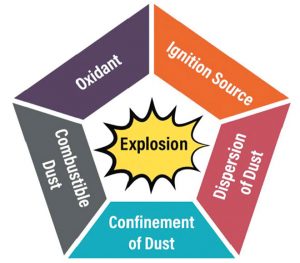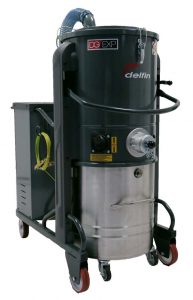Explosion IECEx Vacuums
Flour and grain dust are combustible in nature and can cause an explosion if exposed to the right components. The dangers involved with such dust explosions are serious and can cause destruction of facilities and company assets, and more tragically, injuries and loss of lives. Why run the risk of a dust explosion when there are simple measures that can be implemented to prevent the risk
 A common mistake made with flour dust in mills and manufacturing facilities is to believe that because the facility has been operating for years without a dust explosion, it must be safe. However it’s vital to know that this is not a valid basis for determining whether you are actually doing a good job preventing a dust explosion. More likely, you have just been extremely lucky and it has simply, not happened yet. Operating businesses under the precedence of luck is simply not viable, especially when employees’ safety is at stake
A common mistake made with flour dust in mills and manufacturing facilities is to believe that because the facility has been operating for years without a dust explosion, it must be safe. However it’s vital to know that this is not a valid basis for determining whether you are actually doing a good job preventing a dust explosion. More likely, you have just been extremely lucky and it has simply, not happened yet. Operating businesses under the precedence of luck is simply not viable, especially when employees’ safety is at stake
There have been many serious incidents involving combustible dust explosions in mills and manufacturing facilities. Arguably one of the most detrimental, the explosion at Washburn ‘A’ Flour Mill, claiming 18 lives and causing major damage to the property and surrounds.
Combustible dust particles can accumulate at any time and cause an explosion as long as exposed to specific factors. That is, dust explosions occur when combustible dust is airborne in a room or inside equipment. When mixed with oxygen, these fine particles can be ignited by any type of ignition source.
At flour mills, airborne dust particles are released into the air at almost every stage in the processing facility including initial grinding, loading, sifting, drying and packaging.
However, flour mills are not the only ones at risk. Commercial bakeries and food manufacturers dealing with flour can produce high volumes of flour dust and also run the risk of combustion.
Whilst flour dust is combustible and poses a risk of explosion, it can also be dangerous in terms of inhalation. Breathing in large volumes of grain and flour over a prolonged period can affect the health and overall comfort of workers, thus affecting safety and morale. Exposure can lead to health issues like headaches, muscle aches, tightness of chest, and nausea. In serious cases, asthma, baker’s lung, and organic dust toxic syndrome are all possible.
Mitigate the Explosion Risk with South Pacific Vacuums
 At South Pacific Vacuums, we offer a range of simple solutions for controlling combustible dusts, including our IECEx Certified vacuums that are safe for the extraction of combustible dust. We offer the IECEx Certified DG50 and DG50 Longopac.
At South Pacific Vacuums, we offer a range of simple solutions for controlling combustible dusts, including our IECEx Certified vacuums that are safe for the extraction of combustible dust. We offer the IECEx Certified DG50 and DG50 Longopac.
These vacuums can be implemented as part of a small ducted network which provides many benefits for large mills or facilities. These benefits include:
- Operators can vacuum over long distances from different collection points on the same level – this improves efficiency of cleaning as multiple operators can clean on the same floor, or the one operator can clean from different collection points without having to take an entire vacuum system with them
- Multiple operators can vacuum simultaneously – this decreases downtime of employees waiting to use the vacuum if it’s already in use, and therefore increases productivity and level of actual work produced
- Multiple storeys can be reached through piping – this increases operator acceptance and employee morale as they don’t need to carry heavy equipment upstairs or around the facility
Contact Us about IECEx
Call our Auckland Office on +64 9 520 20 30, Wellington Office +64 4 234 1020 or use the contact form below:
